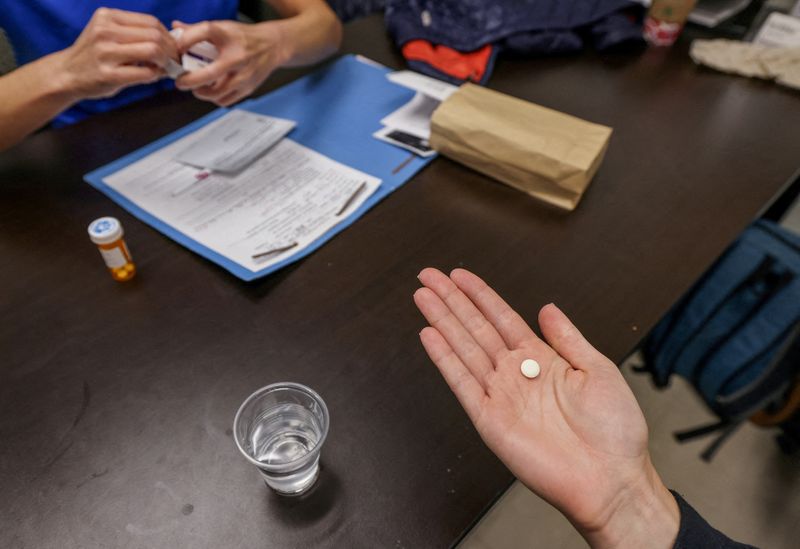Explainer-Can abortion pills overcome U.S. state bans?
2022.06.25 00:20

FILE PHOTO: Dr. Shelly Tien hands a patient the initial abortion inducing medication at Trust Women clinic in Oklahoma City, U.S., December 6, 2021. REUTERS/Evelyn Hockstein/
By Brendan Pierson and Nate Raymond
(Reuters) – Following the U.S. Supreme Court’s June 24 ruling eliminating the nationwide right to abortion that it had recognized nearly 50 years ago in its landmark Roe v. Wade decision, demand for abortion pills, which can be prescribed through online telemedicine visits, will likely rise. However, medication abortion will not necessarily offer a way for most women to avoid the stringent new abortion bans now expected to pass in conservative states, experts say.
WHAT IS A MEDICATION ABORTION?
In a medication abortion, a patient takes a drug called mifepristone, also known as RU-486, followed by a second drug called misoprostol, to end a pregnancy rather than having a surgical procedure. Over half of abortions in the United States are medication abortions, according to the Guttmacher Institute, an abortion rights advocacy research group.
HOW DOES THE FEDERAL GOVERNMENT REGULATE MEDICATION ABORTIONS?
The U.S. Food and Drug Administration approved mifepristone in 2000, but until very recently, the FDA mandated that patients get it at a doctor’s office, clinic or hospital. After easing those restrictions during the COVID-19 pandemic, the agency in December permanently did away with the requirement that it had to be dispensed in person, allowing patients to consult with healthcare providers via telemedicine appointments and receive the pills by mail. That increased access to abortion for patients living in remote areas without providers nearby and women unable to take time off from work or not able to get to clinics for other reasons. The drugs are approved for use through the 10th week of pregnancy.
DO STATES RESTRICT MEDICATION ABORTION?
Yes. Medication abortions have become a target of anti-abortion politicians and activists. Indiana bans medication abortion at 10 weeks, and Texas after seven weeks; other state medication abortion bans have been blocked by courts.
Thirty-two states allow only physicians, and not other clinicians such as nurse practitioners, to dispense abortion pills, according to the Guttmacher Institute. Nineteen states require that the dispensing clinician be in the patient’s physical presence, effectively banning telemedicine.
WHAT IS THE IMPACT OF THE SUPREME COURT’S RULING ON TELEMEDICINE ABORTION?
Before the Supreme Court’s ruling, 13 states had so-called “trigger laws” written to impose new abortion bans immediately or soon after Roe v. Wade was overturned, and other states are expected to follow after Friday’s ruling in Dobbs v. Jackson Women’s Health.
The Guttmacher Institute predicts at least 26 states, including those with trigger laws, will pass new abortion laws. Such state laws have so far not distinguished between surgical and medication abortion, so they are expected to ban medication abortion entirely. Some will ban abortions almost completely, while others outlaw abortion at six weeks or 15 weeks.
U.S. Senator Tina Smith of Minnesota, a Democrat, on Thursday introduced a bill that would ensure that telemedicine abortion is available in states where abortion remains legal in anticipation of the Supreme Court’s ruling.
CAN A PATIENT IN A STATE WHERE MEDICAL ABORTION IS ILLEGAL GET THE PILLS FROM AN OUT-OF-STATE PROVIDER WHERE IT IS LEGAL?
That depends. It is illegal for a medical professional to prescribe the pills via a telemedicine appointment to a woman in a state where they are illegal, legal experts say.
“The laws around telemedicine generally say that the location of the patient controls,” said Amanda Allen, senior counsel at the Lawyering Project, an organization that represents abortion providers. Doctors who prescribed abortion pills to a patient in a state where they are illegal could lose their licenses in that state, or even face criminal charges, she said.
A woman who lives in a state where abortion is illegal could travel to a state where it is legal, have a telemedicine visit, and have the medication mailed to an address there.
“In some cases, that’s somewhat less burdensome and costly than to travel all the way to a brick-and-mortar clinic in a neighboring state,” she said, noting that patients who travel to clinics in other states have sometimes faced weeks-long waits for appointments.
ARE THERE CURRENTLY LAWSUITS CHALLENGING STATE RESTRICTIONS ON MEDICAL ABORTION?
Yes. GenBioPro Inc, a company that sells mifepristone, has already challenged Mississippi’s restrictions on prescribing abortion pills via telemedicine by arguing that they are “preempted” by the FDA, meaning that the federal approval of the drug overrides any state law. There has not been a ruling in that case, which is pending in Mississippi federal court.
Similar challenges have succeeded before. In 2014, a Massachusetts federal judge struck down a state law seeking to regulate opioid drugs more stringently than federal law on the grounds that it was preempted.
U.S. Attorney General Merrick Garland appeared to express support for that position in a statement on the Supreme Court’s June 24 ruling, saying that states “may not ban mifepristone based on disagreement with the FDA’s expert judgment about its safety and efficacy.”
Mississippi has argued that FDA approval cannot overcome the Supreme Court’s rulings granting states authority to regulate abortions.
CAN PATIENTS GET ABORTION PILLS FROM OTHER COUNTRIES?
Yes. Women in states cracking down on telemedicine abortion have increasingly turned to ordering pills online from overseas.
While the practice is not legal, state authorities have said they have no effective way of policing orders from foreign doctors and pharmacies.








